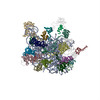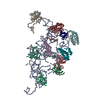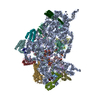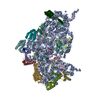+ Open data
Open data
- Basic information
Basic information
| Entry | Database: PDB / ID: 3iy8 | ||||||
|---|---|---|---|---|---|---|---|
| Title | Leishmania tarentolae Mitonchondrial Ribosome small subunit | ||||||
 Components Components |
| ||||||
 Keywords Keywords |  RIBOSOME / Leishmania tarentolae / RIBOSOME / Leishmania tarentolae /  Mitochondrial ribosome / Mitochondrial ribosome /  CryoEM / Minimal RNA. / CryoEM / Minimal RNA. /  Antibiotic resistance / Antibiotic resistance /  Ribonucleoprotein / Ribonucleoprotein /  Ribosomal protein / RNA-binding / rRNA-binding / Ribosomal protein / RNA-binding / rRNA-binding /  Repressor / Translation regulation / tRNA-binding / Repressor / Translation regulation / tRNA-binding /  Methylation / Methylation /  Endonuclease / Endonuclease /  Hydrolase / Hydrolase /  Nuclease Nuclease | ||||||
| Function / homology |  Function and homology information Function and homology informationmisfolded RNA binding / Group I intron splicing / RNA folding / four-way junction DNA binding / regulation of mRNA stability / positive regulation of RNA splicing / DNA endonuclease activity / maintenance of translational fidelity / mRNA 5'-UTR binding / small ribosomal subunit rRNA binding ...misfolded RNA binding / Group I intron splicing / RNA folding / four-way junction DNA binding / regulation of mRNA stability / positive regulation of RNA splicing / DNA endonuclease activity / maintenance of translational fidelity / mRNA 5'-UTR binding / small ribosomal subunit rRNA binding /  ribosomal small subunit assembly / cytosolic small ribosomal subunit / ribosomal small subunit assembly / cytosolic small ribosomal subunit /  regulation of translation / small ribosomal subunit / cytoplasmic translation / regulation of translation / small ribosomal subunit / cytoplasmic translation /  tRNA binding / molecular adaptor activity / tRNA binding / molecular adaptor activity /  rRNA binding / rRNA binding /  ribosome / structural constituent of ribosome / ribosome / structural constituent of ribosome /  translation / translation /  ribonucleoprotein complex / response to antibiotic / ribonucleoprotein complex / response to antibiotic /  RNA binding / zinc ion binding / RNA binding / zinc ion binding /  cytosol / cytosol /  cytoplasm cytoplasmSimilarity search - Function | ||||||
| Biological species |  Leishmania tarentolae (eukaryote) Leishmania tarentolae (eukaryote)  Escherichia coli (E. coli) Escherichia coli (E. coli) | ||||||
| Method |  ELECTRON MICROSCOPY / ELECTRON MICROSCOPY /  single particle reconstruction / single particle reconstruction /  cryo EM / Resolution: 14.1 Å cryo EM / Resolution: 14.1 Å | ||||||
 Authors Authors | Sharma, M.R. / Booth, T.M. / Simpson, L. / Maslov, D.A. / Agrawal, R.K. | ||||||
 Citation Citation |  Journal: Proc Natl Acad Sci U S A / Year: 2009 Journal: Proc Natl Acad Sci U S A / Year: 2009Title: Structure of a mitochondrial ribosome with minimal RNA. Authors: Manjuli R Sharma / Timothy M Booth / Larry Simpson / Dmitri A Maslov / Rajendra K Agrawal /  Abstract: The Leishmania tarentolae mitochondrial ribosome (Lmr) is a minimal ribosomal RNA (rRNA)-containing ribosome. We have obtained a cryo-EM map of the Lmr. The map reveals several features that have not ...The Leishmania tarentolae mitochondrial ribosome (Lmr) is a minimal ribosomal RNA (rRNA)-containing ribosome. We have obtained a cryo-EM map of the Lmr. The map reveals several features that have not been seen in previously-determined structures of eubacterial or eukaryotic (cytoplasmic or organellar) ribosomes to our knowledge. Comparisons of the Lmr map with X-ray crystallographic and cryo-EM maps of the eubacterial ribosomes and a cryo-EM map of the mammalian mitochondrial ribosome show that (i) the overall structure of the Lmr is considerably more porous, (ii) the topology of the intersubunit space is significantly different, with fewer intersubunit bridges, but more tunnels, and (iii) several of the functionally-important rRNA regions, including the alpha-sarcin-ricin loop, have different relative positions within the structure. Furthermore, the major portions of the mRNA channel, the tRNA passage, and the nascent polypeptide exit tunnel contain Lmr-specific proteins, suggesting that the mechanisms for mRNA recruitment, tRNA interaction, and exiting of the nascent polypeptide in Lmr must differ markedly from the mechanisms deduced for ribosomes in other organisms. Our study identifies certain structural features that are characteristic solely of mitochondrial ribosomes and other features that are characteristic of both mitochondrial and chloroplast ribosomes (i.e., organellar ribosomes). | ||||||
| History |
|
- Structure visualization
Structure visualization
| Movie |
 Movie viewer Movie viewer |
|---|---|
| Structure viewer | Molecule:  Molmil Molmil Jmol/JSmol Jmol/JSmol |
- Downloads & links
Downloads & links
- Download
Download
| PDBx/mmCIF format |  3iy8.cif.gz 3iy8.cif.gz | 71.6 KB | Display |  PDBx/mmCIF format PDBx/mmCIF format |
|---|---|---|---|---|
| PDB format |  pdb3iy8.ent.gz pdb3iy8.ent.gz | 39.2 KB | Display |  PDB format PDB format |
| PDBx/mmJSON format |  3iy8.json.gz 3iy8.json.gz | Tree view |  PDBx/mmJSON format PDBx/mmJSON format | |
| Others |  Other downloads Other downloads |
-Validation report
| Arichive directory |  https://data.pdbj.org/pub/pdb/validation_reports/iy/3iy8 https://data.pdbj.org/pub/pdb/validation_reports/iy/3iy8 ftp://data.pdbj.org/pub/pdb/validation_reports/iy/3iy8 ftp://data.pdbj.org/pub/pdb/validation_reports/iy/3iy8 | HTTPS FTP |
|---|
-Related structure data
| Related structure data |  5113MC  3iy9C M: map data used to model this data C: citing same article ( |
|---|---|
| Similar structure data |
- Links
Links
- Assembly
Assembly
| Deposited unit | 
|
|---|---|
| 1 |
|
- Components
Components
-RNA chain , 1 types, 1 molecules A
| #1: RNA chain | Mass: 172221.844 Da / Num. of mol.: 1 / Source method: isolated from a natural source / Source: (natural)  Leishmania tarentolae (eukaryote) Leishmania tarentolae (eukaryote) |
|---|
-30S ribosomal protein ... , 10 types, 10 molecules EFHIKLOPQR
| #2: Protein |  / Coordinate model: Cα atoms only / Coordinate model: Cα atoms onlyMass: 15804.282 Da / Num. of mol.: 1 / Source method: isolated from a natural source / Source: (natural)   Escherichia coli (E. coli) / References: UniProt: P0A7W1 Escherichia coli (E. coli) / References: UniProt: P0A7W1 |
|---|---|
| #3: Protein |  / Coordinate model: Cα atoms only / Coordinate model: Cα atoms onlyMass: 11669.371 Da / Num. of mol.: 1 / Source method: isolated from a natural source / Source: (natural)   Escherichia coli (E. coli) / References: UniProt: P02358 Escherichia coli (E. coli) / References: UniProt: P02358 |
| #4: Protein |  / Coordinate model: Cα atoms only / Coordinate model: Cα atoms onlyMass: 14015.361 Da / Num. of mol.: 1 / Source method: isolated from a natural source / Source: (natural)   Escherichia coli (E. coli) / References: UniProt: P0A7W7 Escherichia coli (E. coli) / References: UniProt: P0A7W7 |
| #5: Protein |  / Coordinate model: Cα atoms only / Coordinate model: Cα atoms onlyMass: 14554.882 Da / Num. of mol.: 1 / Source method: isolated from a natural source / Source: (natural)   Escherichia coli (E. coli) / References: UniProt: P0A7X3 Escherichia coli (E. coli) / References: UniProt: P0A7X3 |
| #6: Protein |  / Coordinate model: Cα atoms only / Coordinate model: Cα atoms onlyMass: 12487.200 Da / Num. of mol.: 1 / Source method: isolated from a natural source / Source: (natural)   Escherichia coli (E. coli) / References: UniProt: P0A7R9 Escherichia coli (E. coli) / References: UniProt: P0A7R9 |
| #7: Protein |  / Coordinate model: Cα atoms only / Coordinate model: Cα atoms onlyMass: 13636.961 Da / Num. of mol.: 1 / Source method: isolated from a natural source / Source: (natural)   Escherichia coli (E. coli) / References: UniProt: P0A7S3 Escherichia coli (E. coli) / References: UniProt: P0A7S3 |
| #8: Protein |  / Coordinate model: Cα atoms only / Coordinate model: Cα atoms onlyMass: 10188.687 Da / Num. of mol.: 1 / Source method: isolated from a natural source / Source: (natural)   Escherichia coli (E. coli) / References: UniProt: Q8X9M2 Escherichia coli (E. coli) / References: UniProt: Q8X9M2 |
| #9: Protein |  / Coordinate model: Cα atoms only / Coordinate model: Cα atoms onlyMass: 9207.572 Da / Num. of mol.: 1 / Source method: isolated from a natural source / Source: (natural)   Escherichia coli (E. coli) / References: UniProt: P0A7T3 Escherichia coli (E. coli) / References: UniProt: P0A7T3 |
| #10: Protein |  / Coordinate model: Cα atoms only / Coordinate model: Cα atoms onlyMass: 9263.946 Da / Num. of mol.: 1 / Source method: isolated from a natural source / Source: (natural)   Escherichia coli (E. coli) / References: UniProt: P0AG63 Escherichia coli (E. coli) / References: UniProt: P0AG63 |
| #11: Protein |  / Coordinate model: Cα atoms only / Coordinate model: Cα atoms onlyMass: 6466.477 Da / Num. of mol.: 1 / Source method: isolated from a natural source / Source: (natural)   Escherichia coli (E. coli) / References: UniProt: Q1R358 Escherichia coli (E. coli) / References: UniProt: Q1R358 |
-Experimental details
-Experiment
| Experiment | Method:  ELECTRON MICROSCOPY ELECTRON MICROSCOPY |
|---|---|
| EM experiment | Aggregation state: PARTICLE / 3D reconstruction method:  single particle reconstruction single particle reconstruction |
- Sample preparation
Sample preparation
| Component | Name: Leishmania Mitochondrial 50S Ribosome / Type: RIBOSOME / Details: Monomer |
|---|---|
| Molecular weight | Value: 2.1 MDa / Experimental value: YES |
| Buffer solution | pH: 7.5 Details: 50 mM Tris-HCl, pH 7.5, 100 mM KCl, 10 mM MgCl2, 3 mM DTT, 0.1 mM EDTA and 0.05% dodecyl maltoside |
| Specimen | Conc.: 0.067 mg/ml / Embedding applied: NO / Shadowing applied: NO / Staining applied : NO / Vitrification applied : NO / Vitrification applied : YES : YESDetails: 50 mM Tris-HCl, pH 7.5, 100 mM KCl, 10 mM MgCl2, 3 mM DTT, 0.1 mM EDTA and 0.05% dodecyl maltoside |
Vitrification | Instrument: FEI VITROBOT MARK I / Cryogen name: ETHANE / Humidity: 90 % / Method: Plunge freeze |
- Electron microscopy imaging
Electron microscopy imaging
| Experimental equipment |  Model: Tecnai F20 / Image courtesy: FEI Company |
|---|---|
| Microscopy | Model: FEI TECNAI F20 |
| Electron gun | Electron source : :  FIELD EMISSION GUN / Accelerating voltage: 200 kV / Illumination mode: FLOOD BEAM FIELD EMISSION GUN / Accelerating voltage: 200 kV / Illumination mode: FLOOD BEAM |
| Electron lens | Mode: BRIGHT FIELD Bright-field microscopy / Nominal magnification: 50000 X / Calibrated magnification: 50760 X / Nominal defocus max: 4500 nm / Nominal defocus min: 1600 nm / Camera length: 0 mm Bright-field microscopy / Nominal magnification: 50000 X / Calibrated magnification: 50760 X / Nominal defocus max: 4500 nm / Nominal defocus min: 1600 nm / Camera length: 0 mm |
| Specimen holder | Specimen holder model: OTHER / Specimen holder type: eucentric / Temperature: 80 K / Tilt angle max: 0 ° / Tilt angle min: 0 ° |
| Image recording | Film or detector model: KODAK SO-163 FILM |
| Radiation | Protocol: SINGLE WAVELENGTH / Monochromatic (M) / Laue (L): M / Scattering type: x-ray |
| Radiation wavelength | Relative weight: 1 |
- Processing
Processing
| EM software | Name: SPIDER / Category: 3D reconstruction | ||||||||||||
|---|---|---|---|---|---|---|---|---|---|---|---|---|---|
CTF correction | Details: Each Micrograph | ||||||||||||
| Symmetry | Point symmetry : C1 (asymmetric) : C1 (asymmetric) | ||||||||||||
3D reconstruction | Method: Projection Matching / Resolution: 14.1 Å / Resolution method: FSC 0.5 CUT-OFF / Num. of particles: 53475 / Symmetry type: POINT | ||||||||||||
| Atomic model building | Space: REAL | ||||||||||||
| Refinement step | Cycle: LAST
|
 Movie
Movie Controller
Controller











 PDBj
PDBj





























